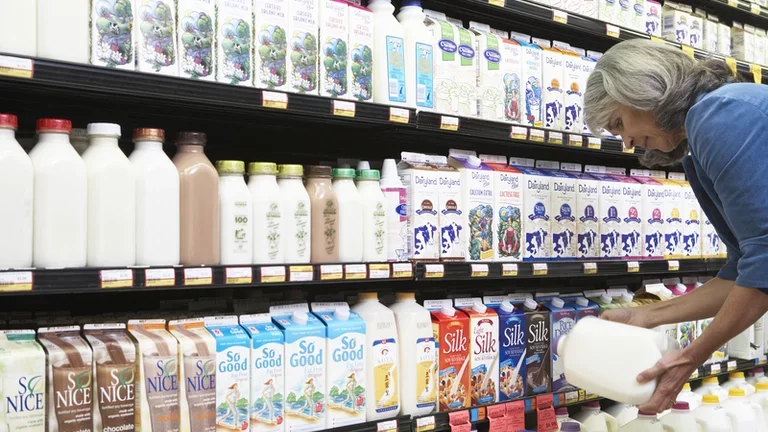Test your knowledge of Air Liquide and the agri-food sector!
Published on March 24, 2023
8 minutes

Freezing, chilling, packaging, inerting or transporting products under controlled temperatures... the food industry is a key sector for Air Liquide. The Group has always supported professionals in this sector throughout their value chain "from farm to fork".
What is the agri-food sector?
True!
By providing certified gases, equipment and services, in particular, Air Liquide helps its food industry customers and partners to produce, transform, package, transport and distribute their products across the entire food chain, all while ensuring a high-quality standard, reducing their carbon footprint and minimizing losses.
False!
By providing certified gases, equipment and services, in particular, Air Liquide helps its food industry customers and partners to produce, transform, package, transport and distribute their products across the entire food chain, all while ensuring a high-quality standard, reducing their carbon footprint and minimizing losses.
False!
By providing certified gases, equipment and services, in particular, Air Liquide helps its food industry customers and partners to produce, transform, package, transport and distribute their products across the entire food chain, all while ensuring a high-quality standard, reducing their carbon footprint and minimizing losses.
Air Liquide partners with the agri-food industry by offering:
True!
Air Liquide has been supporting the entire food value chain for more than 100 years by offering a number of quality solutions that comply with the environmental standards and regulations. These solutions include freezing, modified-atmosphere packaging, beverage carbonation, tank inerting for oxygen-sensitive products, wastewater treatment, crop disinsectization and fish farm oxygenation. They make it possible to preserve the quality and taste of food products, from farm to fork!
True!
Air Liquide has been supporting the entire food value chain for more than 100 years by offering a number of quality solutions that comply with the environmental standards and regulations. These solutions include freezing, modified-atmosphere packaging, beverage carbonation, tank inerting for oxygen-sensitive products, wastewater treatment, crop disinsectization and fish farm oxygenation. They make it possible to preserve the quality and taste of food products, from farm to fork!
False!
Air Liquide has been supporting the entire food value chain for more than 100 years by offering a number of quality solutions that comply with the environmental standards and regulations. These solutions include freezing, modified-atmosphere packaging, beverage carbonation, tank inerting for oxygen-sensitive products, wastewater treatment, crop disinsectization and fish farm oxygenation. They make it possible to preserve the quality and taste of food products, from farm to fork!
What are the key changes and major challenges affecting this sector?
True!
All of the answers are correct! The population is expected to grow to 10 billion people by 2050 and we do not have sufficient production capacity to feed everyone. Therefore, we need to find a way to produce more and better, using fewer natural resources. Consumers are increasingly opting for responsible, environmentally friendly diets and are showing concern regarding animal welfare. We are in the midst of a food transition that is affecting everyone in the food chain.
True!
All of the answers are correct! The population is expected to grow to 10 billion people by 2050 and we do not have sufficient production capacity to feed everyone. Therefore, we need to find a way to produce more and better, using fewer natural resources. Consumers are increasingly opting for responsible, environmentally friendly diets and are showing concern regarding animal welfare. We are in the midst of a food transition that is affecting everyone in the food chain.
True!
All of the answers are correct! The population is expected to grow to 10 billion people by 2050 and we do not have sufficient production capacity to feed everyone. Therefore, we need to find a way to produce more and better, using fewer natural resources. Consumers are increasingly opting for responsible, environmentally friendly diets and are showing concern regarding animal welfare. We are in the midst of a food transition that is affecting everyone in the food chain.
What is food cryogenics?
False!
Cryogenic refrigeration (using nitrogen or CO2) is used in transformation processes (deep-freezing, freezing, rapid cooling), in refrigerated transport and when selling agri-food products. In contrast to mechanical refrigeration, this preservation technique allows food products to be quickly chilled to very low temperatures, which enables taste and quality to be preserved over time.
In particular, Air Liquide developed the Nexelia solution to optimize its customers’ cryogenic processes.
True!
Cryogenic refrigeration (using nitrogen or CO2) is used in transformation processes (deep-freezing, freezing, rapid cooling), in refrigerated transport and when selling agri-food products. In contrast to mechanical refrigeration, this preservation technique allows food products to be quickly chilled to very low temperatures, which enables taste and quality to be preserved over time.
In particular, Air Liquide developed the Nexelia solution to optimize its customers’ cryogenic processes.
False!
Cryogenic refrigeration (using nitrogen or CO2) is used in transformation processes (deep-freezing, freezing, rapid cooling), in refrigerated transport and when selling agri-food products. In contrast to mechanical refrigeration, this preservation technique allows food products to be quickly chilled to very low temperatures, which enables taste and quality to be preserved over time.
In particular, Air Liquide developed the Nexelia solution to optimize its customers’ cryogenic processes.
Why is water management a major challenge at present?
False!
Even if it seems like there is plenty of water on Earth, we do not have an endless supply. The current scarcity of water and the competition caused by its wide range of uses mean that we need to reduce our consumption and increase the circular economy so as to make better use of this precious resource.
Agriculture is responsible for 70% of global freshwater use. The stakeholders in this sector are working toward the following three objectives:
- 1) Reduce consumption and, in particular, prevent needless waste and ensure that water is only discharged into the environment when necessary;
- 2) Reuse water for different tasks, when quality allows;
- 3) Recycle water, i.e. treat wastewater to give it a new “lease on life” and release it into the environment. This treated water must not contain any substances harmful to biodiversity. 80% of wastewater is still released into the environment without having been treated.
True!
Even if it seems like there is plenty of water on Earth, we do not have an endless supply. The current scarcity of water and the competition caused by its wide range of uses mean that we need to reduce our consumption and increase the circular economy so as to make better use of this precious resource.
All the stakeholders in this sector are working toward the following three objectives:
- 1) Reduce consumption and, in particular, prevent needless waste and ensure that water is only discharged into the environment when necessary;
- 2) Reuse water for different tasks, when quality allows;
- 3) Recycle water, i.e. treat wastewater to give it a new “lease on life” and release it into the environment. This treated water must not contain any substances harmful to biodiversity. 80% of wastewater is still released into the environment without having been treated.
True!
Even if it seems like there is plenty of water on Earth, we do not have an endless supply. The current scarcity of water and the competition caused by its wide range of uses mean that we need to reduce our consumption and increase the circular economy so as to make better use of this precious resource.
Agriculture is responsible for 70% of global freshwater use. The stakeholders in this sector are working toward the following three objectives:
- 1) Reduce consumption and, in particular, prevent needless waste and ensure that water is only discharged into the environment when necessary;
- 2) Reuse water for different tasks, when quality allows;
- 3) Recycle water, i.e. treat wastewater to give it a new “lease on life” and release it into the environment. This treated water must not contain any substances harmful to biodiversity. 80% of wastewater is still released into the environment without having been treated.
What is modified-atmosphere packaging (MAP)?
False!
Fresh foods naturally decompose when they come into contact with ambient air. Modified-atmosphere packaging allows them to retain their freshness and organoleptic qualities (related to our senses) for five times as long. These products can therefore withstand longer delivery times and travel further. In addition, this specially designed, biosourced packaging with an attractive design is further developed every day.
True!
Fresh foods naturally decompose when they come into contact with ambient air. Modified-atmosphere packaging allows them to retain their freshness and organoleptic qualities (related to our senses) for five times as long. These products can therefore withstand longer delivery times and travel further. In addition, this specially designed, biosourced packaging with an attractive design is further developed every day.
False!
Fresh foods naturally decompose when they come into contact with ambient air. Modified-atmosphere packaging allows them to retain their freshness and organoleptic qualities (related to our senses) for five times as long. These products can therefore withstand longer delivery times and travel further. In addition, this specially designed, biosourced packaging with an attractive design is further developed every day.
What are Air Liquide’s objectives in the agri-food sector?
True!
All of the answers are correct! Whether through freezing, modified-atmosphere packaging, taste and quality preservation, beverage carbonation, tank inerting for oxygen-sensitive products… Our objective is to improve the quality and guarantee the safety of products throughout the food transformation and distribution chains, all while supporting our customers through their energy transition.
True!
All of the answers are correct! Whether through freezing, modified-atmosphere packaging, taste and quality preservation, beverage carbonation, tank inerting for oxygen-sensitive products… Our objective is to improve the quality and guarantee the safety of products throughout the food transformation and distribution chains, all while supporting our customers through their energy transition.
True!
All of the answers are correct! Whether through freezing, modified-atmosphere packaging, taste and quality preservation, beverage carbonation, tank inerting for oxygen-sensitive products… Our objective is to improve the quality and guarantee the safety of products throughout the food transformation and distribution chains, all while supporting our customers through their energy transition.
Discover our podcast
All our other podcasts (only in french)


